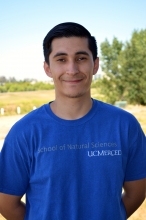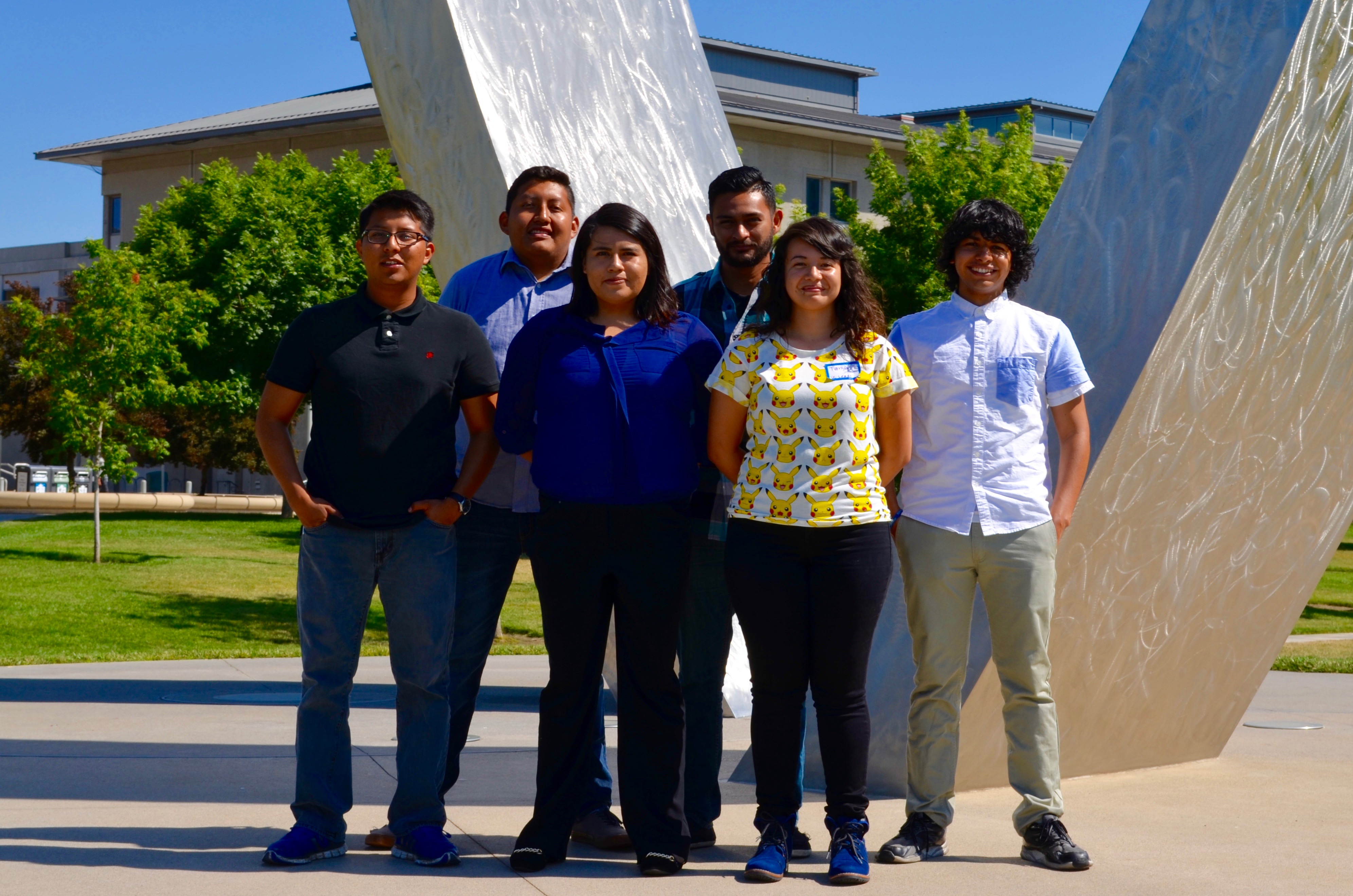Jesus Campos Gatica
Jesus Campos Gatica graduated from Granite Hills High School in Porterville, CA in May 2013. He decided to attend the University of California, Merced, where he is currently a fourth year undergraduate student with an Applied Mathematics major Emphasis in Economics. He expects to graduate in the spring of 2017. Jesus is grateful for the opportunity to do something great this summer, for the opportunity to do research in the field of his choice and to be able to explore something different. Jesus enjoys playing soccer and basketball and enjoys learning new things.
Population Structure and Local Adaptation Through the X Chromosome
Jesus Campos Gatica, Emilia Huerta-Sanchez, PhD; School of Natural Sciences, University of California, Merced
Interest in human evolutionary biology, is the understanding of natural selection and demographic history's influence on DNA sequence variation in humans. We will investigate how selective pressures and demographic factors have affected the observed genetic variation on the X chromosome. Most of what we know about population genetic analysis involves autosomes; this is because both males and females possess the same number of autosomal chromosomes. Through the usage of public data sets provided by the 1000 Genomes Project we will run different analysis, through which we will be able to observe any similar population structure between the X chromosome and the autosomes. In the investigation signals of local adaptation in the X chromosome will make it possible to understand what genetic phenotype they are responsible for in terms of genetic variation. We hypothesize to be able to obtain the same levels of population structure observed in the autosomes with the X chromosome. Moreover, study of the X chromosome may reveal the genomic signatures of recessive deleterious mutations, undergoing strong negative selection, that are a significant component of inherited human disease.
David Delgadillo
 |
Major: Biology-Chemistry
Home City: Hacienda Heights, CA
Contact: ddelgadillo3@ucmerced.edu
Faculty Mentor: Professor R. David Britt (UC Davis)
|
David Delgadillo is entering his third year at UC Merced and is majoring in Human Biology while minoring in Chemistry. David comes from a household of nine. He learned the importance of giving back to the community at a young age by volunteering at local food pantries, and later volunteering at his local Kaiser Permanente Medical Center. David also works as a Resident Assistant during the academic year and assists students by making their transition to college less stressful. He aspires to attain both MD and PhD degrees and practice anesthesiology in the near future.
Victor Hernandez
 |
Major: Material Sciences and Engineering
Home City:
Contact: vhernandez34@ucmerced.edu
Faculty Mentor: Professor Anand Subramaniam
|
Victor Hugo Hernandez Carreno is a fourth-year undergraduate student in Material Science and Engineering with a special interest in rudimentary nano-science application such as battery improvement, quantum dots, and polymeric material. As the founder and Executive Director of Student Advocating Law & Education he worked to create new opportunity for his community. Now provided with this amazing opportunity, Victor is eager and excited to gain more experience in his field. He enjoys learning new things and discovering new perspectives to ideas.
Micro-Patterning Lipid Bilayer on Paper
Victor Hernandez, Anand B. Subramaniam, PhD; School of Engineering, University of California, Merced
Cellulose is an abundant natural and sustainable resource that is of great interest in the research community due to its versatility and biocompatibility. The purpose of this project it to demonstrate this versatility at the microscale by depositing lipid membranes. A nanopaper substrate was used to support the lipid membrane. We use microcontact printing from poly(dimethyl)siloxane stamps to deposit circular and line features from 5mg/mL of the lipid mixture dioleoylphosphatidylcholine:TopFlour cholesterol at 99:1 mole percent. We were able to transfer features of about 40-80 micrometers onto the nanopaper surface. To test for the presence of the bilayer, we conducted fluorescence recovery after photopbleaching (FRAP) to measure the mobility of the transferred lipid film. In some cases, we observed recovery after photobleaching, which confirmed that a bilayer or monolayer was formed. The majority of our experiments however showed no recovery which suggests that a continuous bilayer was not formed on the paper surface. Further optimization was needed to demonstrate that nanofibrillated cellulose can be used with lipids for bio- medical application and biomaterials research.
Ebelin Hernandez
Thermal Management System for Lithium-Ion Batteries in Vehicles Using Minichannel Tubes
Ebelin Hernandez, Ahmed A. Merrouni, Trenton Berner, Juan Rodriguez, Stephen Chan, and Angel Sepulveda, Yanbao Ma, PhD; School of Engineering, University of California, Merced
Thermal management for lithium-ion batteries in electric vehicles (EVs) and hybrid electric vehicles (HEVs) is required for optimal performance. In extreme climates, electrode degradation affect the reliability and performance of the Li-ion batteries. Current thermal management consist of air cooling due to its simple design, low cost, and maintenance control. The issue with air cooling systems is its sensitivity to temperature. Air cooling may not be sufficient enough to cool or heat the Li-ion batteries at a desirable temperature range. The objective of this study is to design, develop and test a new cost efficient, compact thermal management system using aluminum minichannel tubes. The setup utilizes an active, parallel, liquid cooling thermal management system. This is done so by connecting four aluminum minichannels (137×20×2 mm) to two cylindrical metal tubes, one on each side. The metal tubes are thus connected in parallel along a plastic tube. A pump is used to circulate liquid coolant throughout the system. The first set of results concluded in an ambient temperature of 45°C. The developed thermal management system by aluminum minichannel tubes was capable to keep the battery’s average temperature in the optimal operating range (below 35°C). Furthermore, the current thermal management system is compact and cost effective, however, further developments are under- study in order to adapt it with various battery sizes.
Daniel Sanchez Garrido
Daniel Sanchez is a third year undergraduate student in the School of Engineering. He recently transferred from Merced community college for the 2016 spring semester. During his time at Merced Community College, Daniel was involved in several extracurricular activities such as being part of AGS Honor Society, Science Math and Engineering club and STEM Journal Club. Additionally, he was able to earn four Associate Degrees in the fields of Automotive Technology, Engineering, Physics and Mathematics. Now at UC Merced Daniel continues to demonstrate his passion for his major as he keeps taking part in extracurricular activities and joining organizations in his field of study such as Ingenieros Unidos SHPE and Theta Tau Professional Fraternity of Engineers. Daniel has great determination for success that is fueled by his dreams and work ethic which were cultivated by his parents. Furthermore, he seeks to fulfill his next goal of obtaining a Bachelors in Engineering. Daniel dreams of one day going to graduate school and having a career in the automotive industry.
Tribology, Lubricant Performance and Additive Effectiveness
Daniel Sanchez Garrido, Ashlie Martini, PhD; School of Engineering, University of California, Merced
Mechanical component systems require lubricants to meet or exceed rigorous industry standards in order to achieve energy efficiency. Lubricant performance is defined by its ability to maintain lubricating properties under various conditions and environments. Fully formulated oil is a lubricant that consists of base oil mixed with additives such as a Detergent Inhibitor (DI) Package and Viscosity Index (VI) Improver. The DI contains several chemicals, including a foam inhibitor to help control the formation of foam and VI to maintain acceptable viscosity index. Furthermore, lubricants are filtered in an attempt to achieve acceptable levels of cleanliness. However, they cannot be filtered too much as it could undesirably filter out additives. The goal of this study is to optimize the formulation of base oil, additives and filtration cycles in order to pin point the optimal performance conditions for fully formulated oil. Testing was performed to analyze the lubricant performance via a custom-built blending and filtration station. Additives such as the DI and VI packages were found to enhance the properties of the base oil. Lubricants with high performance levels will improve mechanical energy efficiency by reducing friction and component wear. In essence, the incorporation of additives along with an ideal number of filtration cycles will enable optimization of both the effectiveness and performance of fully formulated oil. Hence, this work contributes to mechanical engineering by addressing the issue of energy inefficiency due to friction and lack of lubrication.
Tanya Tafolla
 |
Major: Applied Mathematics
Home City: Delhi, CA
Contact: ttafolla@ucmerced.edu
Faculty Mentor: Professor Francois Blanchett
|
Tanya Tafolla is a central valley native coming from the small town of Delhi, California. Tanya’s affinity for math started around middle school and continued throughout high school. In high school, she used her math skills for a variety of regional competitions for FBLA. Currently, Tanya is an incoming fourth year Applied Mathematics major at UC Merced and expects to graduate in the Spring of 2017. Throughout her time here, she joined the club SHPE but continues to spend more time focusing on her courses. Over the summers, she works at the farmer’s market selling a variety of fruits. On her free time, she enjoys relaxing with her family, playing tennis and video games.
Continuous Model of Penguin Huddle Dynamics
Tanya Tafolla and Francois Blanchette, PhD; School of Natural Sciences, University of California, Merced
Penguins in Antarctica huddle during severe windy weather in order to preserve energy. In order to understand how they manage to survive the harsh conditions, we describe a mathematical model for the huddles to represent the heat flux as a continuous function. In order to obtain the flux, we have to calculated the wind around the huddle and how the heat distributes. The wind distribution is obtained through complex mapping. Once our domain is simplified, we map the outside of our domain to the inside in order to have a finite area or the wind distribution. Having a finite area will be practical for numerical techniques because the temperature inside the disk is solved numerically using spectral methods. From the temperature profile, the flux is obtained at every point. Thus, we can start deforming the huddle boundary with the velocity proportional to the heat flux in an area preserving manner. Once we have a new position of the huddle, we can iterate the position to continue the next evolution in time. Our model will contribute to the fundamental understanding of penguins.








